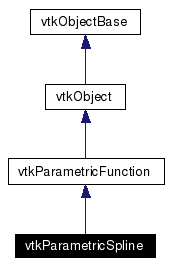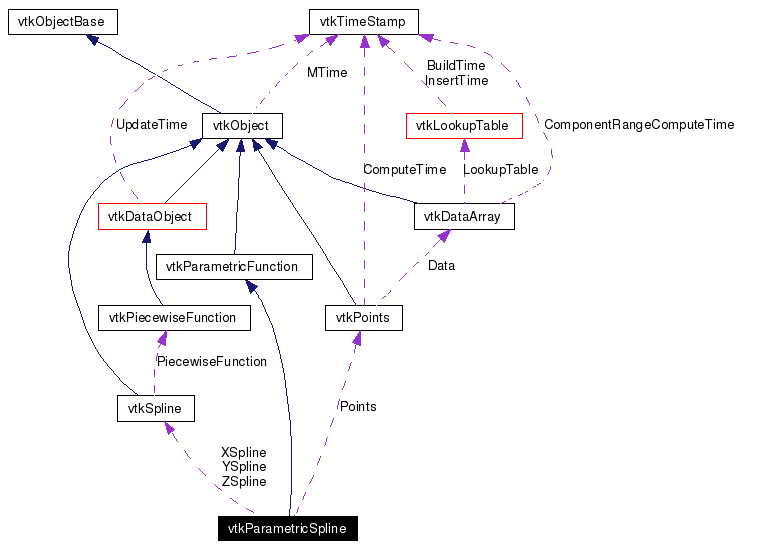vtkParametricSpline Class Reference
#include <vtkParametricSpline.h>
Inheritance diagram for vtkParametricSpline:
 [legend]Collaboration diagram for vtkParametricSpline:
[legend]Collaboration diagram for vtkParametricSpline: [legend]List of all members.
[legend]List of all members.
Detailed Description
parametric function for 1D interpolating splines
vtkParametricSpline is a parametric function for 1D interpolating splines. vtkParametricSpline maps the single parameter u into a 3D point (x,y,z) using three instances of interpolating splines. This family of 1D splines is quaranteed to be parameterized in the interval [0,1]. Attempting to evaluate outside this interval will cause the parameter u to be clamped in the range [0,1].
When constructed, this class creates instances of vtkCardinalSpline for each of the x-y-z coordinates. The user may choose to replace these with their own instances of subclasses of vtkSpline.
- Warning:
- If you wish to tessellate the spline, use the class vtkParametricFunctionSource.
- See also:
- vtkSpline vtkKochanekSpline vtkCardinalSpline
- Tests:
- vtkParametricSpline (Tests)
Definition at line 48 of file vtkParametricSpline.h.
Member Typedef Documentation
Constructor & Destructor Documentation
| vtkParametricSpline::vtkParametricSpline |
( |
|
) |
[protected] |
|
| vtkParametricSpline::~vtkParametricSpline |
( |
|
) |
[protected] |
|
Member Function Documentation
| virtual const char* vtkParametricSpline::GetClassName |
( |
|
) |
[virtual] |
|
| static int vtkParametricSpline::IsTypeOf |
( |
const char * |
type |
) |
[static] |
|
|
|
Return 1 if this class type is the same type of (or a subclass of) the named class. Returns 0 otherwise. This method works in combination with vtkTypeRevisionMacro found in vtkSetGet.h.
Reimplemented from vtkParametricFunction. |
| virtual int vtkParametricSpline::IsA |
( |
const char * |
type |
) |
[virtual] |
|
|
|
Return 1 if this class is the same type of (or a subclass of) the named class. Returns 0 otherwise. This method works in combination with vtkTypeRevisionMacro found in vtkSetGet.h.
Reimplemented from vtkParametricFunction. |
| void vtkParametricSpline::PrintSelf |
( |
ostream & |
os, |
|
|
vtkIndent |
indent |
|
) |
[virtual] |
|
|
|
Methods invoked by print to print information about the object including superclasses. Typically not called by the user (use Print() instead) but used in the hierarchical print process to combine the output of several classes.
Reimplemented from vtkParametricFunction. |
|
|
Construct the spline with the following parameters: MinimumU = 0, MaximumU = 1, JoinU = 0 (unless the spline is closed, then JoinU = 1), TwistU = 0, DerivativesSupplied = 0 (the other vtkParametricFunction parameters are ignored).
Reimplemented from vtkObject. |
| virtual int vtkParametricSpline::GetDimension |
( |
|
) |
[inline, virtual] |
|
| virtual void vtkParametricSpline::Evaluate |
( |
double |
u[3], |
|
|
double |
Pt[3], |
|
|
double |
Du[9] |
|
) |
[virtual] |
|
|
|
Evaluate the spline at parametric coordinate u[0] returning the point coordinate Pt[3].
Implements vtkParametricFunction. |
| virtual double vtkParametricSpline::EvaluateScalar |
( |
double |
u[3], |
|
|
double |
Pt[3], |
|
|
double |
Du[9] |
|
) |
[virtual] |
|
|
|
Evaluate a scalar value at parametric coordinate u[0] and Pt[3]. The scalar value is just the parameter u[0].
Implements vtkParametricFunction. |
| void vtkParametricSpline::SetXSpline |
( |
vtkSpline * |
|
) |
|
|
|
|
By default, this class is constructed with three instances of vtkCardinalSpline (for each of the x-y-z coordinate axes). The user may choose to create and assign their own instances of vtkSpline. |
| void vtkParametricSpline::SetYSpline |
( |
vtkSpline * |
|
) |
|
|
|
|
Evaluate a scalar value at parametric coordinate u[0] and Pt[3]. The scalar value is just the parameter u[0]. |
| void vtkParametricSpline::SetZSpline |
( |
vtkSpline * |
|
) |
|
|
|
|
Evaluate a scalar value at parametric coordinate u[0] and Pt[3]. The scalar value is just the parameter u[0]. |
| virtual vtkSpline* vtkParametricSpline::GetXSpline |
( |
|
) |
[virtual] |
|
|
|
Evaluate a scalar value at parametric coordinate u[0] and Pt[3]. The scalar value is just the parameter u[0]. |
| virtual vtkSpline* vtkParametricSpline::GetYSpline |
( |
|
) |
[virtual] |
|
|
|
Evaluate a scalar value at parametric coordinate u[0] and Pt[3]. The scalar value is just the parameter u[0]. |
| virtual vtkSpline* vtkParametricSpline::GetZSpline |
( |
|
) |
[virtual] |
|
|
|
Evaluate a scalar value at parametric coordinate u[0] and Pt[3]. The scalar value is just the parameter u[0]. |
| void vtkParametricSpline::SetPoints |
( |
vtkPoints * |
|
) |
|
|
|
|
Specify the list of points defining the spline. Do this by specifying a vtkPoints array containing the points. Note that the order of the points in vtkPoints is the order that the splines will be fit. |
| virtual vtkPoints* vtkParametricSpline::GetPoints |
( |
|
) |
[virtual] |
|
|
|
Specify the list of points defining the spline. Do this by specifying a vtkPoints array containing the points. Note that the order of the points in vtkPoints is the order that the splines will be fit. |
| virtual void vtkParametricSpline::SetClosed |
( |
int |
|
) |
[virtual] |
|
|
|
Control whether the spline is open or closed. A closed spline forms a continuous loop: the first and last points are the same, and derivatives are continuous. |
| virtual int vtkParametricSpline::GetClosed |
( |
|
) |
[virtual] |
|
|
|
Control whether the spline is open or closed. A closed spline forms a continuous loop: the first and last points are the same, and derivatives are continuous. |
| virtual void vtkParametricSpline::ClosedOn |
( |
|
) |
[virtual] |
|
|
|
Control whether the spline is open or closed. A closed spline forms a continuous loop: the first and last points are the same, and derivatives are continuous. |
| virtual void vtkParametricSpline::ClosedOff |
( |
|
) |
[virtual] |
|
|
|
Control whether the spline is open or closed. A closed spline forms a continuous loop: the first and last points are the same, and derivatives are continuous. |
| virtual void vtkParametricSpline::SetParameterizeByLength |
( |
int |
|
) |
[virtual] |
|
|
|
Control whether the spline is parameterized by length or by point index. Default is by length. |
| virtual int vtkParametricSpline::GetParameterizeByLength |
( |
|
) |
[virtual] |
|
|
|
Control whether the spline is parameterized by length or by point index. Default is by length. |
| virtual void vtkParametricSpline::ParameterizeByLengthOn |
( |
|
) |
[virtual] |
|
|
|
Control whether the spline is parameterized by length or by point index. Default is by length. |
| virtual void vtkParametricSpline::ParameterizeByLengthOff |
( |
|
) |
[virtual] |
|
|
|
Control whether the spline is parameterized by length or by point index. Default is by length. |
| virtual void vtkParametricSpline::SetLeftConstraint |
( |
int |
|
) |
[virtual] |
|
|
|
Set the type of constraint of the left(right) end points. Four constraints are available: 0: the first derivative at left(right) most point is determined from the line defined from the first(last) two points. 1: the first derivative at left(right) most point is set to Left(Right)Value. 2: the second derivative at left(right) most point is set to Left(Right)Value. 3: the second derivative at left(right)most points is Left(Right)Value times second derivative at first interior point. |
| virtual int vtkParametricSpline::GetLeftConstraint |
( |
|
) |
[virtual] |
|
|
|
Set the type of constraint of the left(right) end points. Four constraints are available: 0: the first derivative at left(right) most point is determined from the line defined from the first(last) two points. 1: the first derivative at left(right) most point is set to Left(Right)Value. 2: the second derivative at left(right) most point is set to Left(Right)Value. 3: the second derivative at left(right)most points is Left(Right)Value times second derivative at first interior point. |
| virtual void vtkParametricSpline::SetRightConstraint |
( |
int |
|
) |
[virtual] |
|
|
|
Set the type of constraint of the left(right) end points. Four constraints are available: 0: the first derivative at left(right) most point is determined from the line defined from the first(last) two points. 1: the first derivative at left(right) most point is set to Left(Right)Value. 2: the second derivative at left(right) most point is set to Left(Right)Value. 3: the second derivative at left(right)most points is Left(Right)Value times second derivative at first interior point. |
| virtual int vtkParametricSpline::GetRightConstraint |
( |
|
) |
[virtual] |
|
|
|
Set the type of constraint of the left(right) end points. Four constraints are available: 0: the first derivative at left(right) most point is determined from the line defined from the first(last) two points. 1: the first derivative at left(right) most point is set to Left(Right)Value. 2: the second derivative at left(right) most point is set to Left(Right)Value. 3: the second derivative at left(right)most points is Left(Right)Value times second derivative at first interior point. |
| virtual void vtkParametricSpline::SetLeftValue |
( |
double |
|
) |
[virtual] |
|
|
|
The values of the derivative on the left and right sides. The value is used only if the left(right) constraint is type 1-3. |
| virtual double vtkParametricSpline::GetLeftValue |
( |
|
) |
[virtual] |
|
|
|
The values of the derivative on the left and right sides. The value is used only if the left(right) constraint is type 1-3. |
| virtual void vtkParametricSpline::SetRightValue |
( |
double |
|
) |
[virtual] |
|
|
|
The values of the derivative on the left and right sides. The value is used only if the left(right) constraint is type 1-3. |
| virtual double vtkParametricSpline::GetRightValue |
( |
|
) |
[virtual] |
|
|
|
The values of the derivative on the left and right sides. The value is used only if the left(right) constraint is type 1-3. |
| int vtkParametricSpline::Initialize |
( |
|
) |
[protected] |
|
Member Data Documentation
The documentation for this class was generated from the following file:
Generated on Tue Jan 22 00:06:03 2008 for VTK by
 1.4.3-20050530
1.4.3-20050530



 1.4.3-20050530
1.4.3-20050530